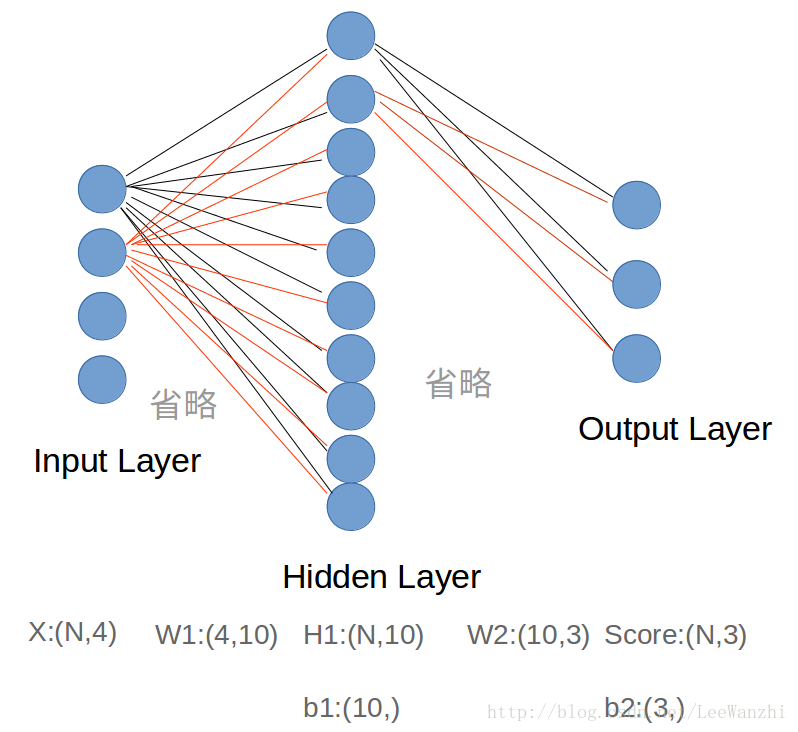神经网络的过程主要就是forward propagation和backward propagation。
forward propagation to evaluate score function & loss function, then back propagation 对每一层计算loss对W和b的梯度,利用梯度完成W和b的更新。
总体过程可以理解为:forward–>backward–>update–>forward–>backward–>update……
一、理论知识
1. 直观理解

这是一个两层的full-connected神经网络,分别是输入层、隐藏层和输出层(输入层不算一层)。输入层4个节点表示样本是4维的,输出层3个节点表示有3类,输出的结果是每个类的score。
FC层(全连接层):每个神经元都连接上一层的所有神经元的layer。
在神经网络中,bigger = better,即网络模型越大越好。more neurons = more capacity,因为机器学习中经常出现模型表达能力不足的情况。
对于神经网络的更形象理解:
2. score function

这里activation function采用的是ReLU函数。
Why we set activation function?
answer:如果不设置activation function,则每层的output都是input的线性函数,则无论隐藏层有多少层,都与没有隐藏层效果一样。因此,设置activation function,目的是为了对input进行非线性转化,然后output,使神经网络更有意义。
3. loss function及求梯度
本次作业中使用的是softmax loss function。可参考softmax classifier。
完成作业的关键仍是loss function对W求梯度。下面求gradient(注意:我在角标表示上有错误,但不影响理解和代码化):

这样,score、loss和gradient都表达出来了,2层神经网络也就可以完成了。
二、Two-layer Neural Network
1. Forward Propagation & Backward Propagation
Forward: 计算score,再根据score计算loss
Backward:分别对W2、b2、W1、b1求梯度
def loss(self, X, y=None, reg=0.0):
"""
Compute the loss and gradients for a two layer fully connected neural
network.
Inputs:
- X: Input data of shape (N, D). Each X[i] is a training sample.
- y: Vector of training labels. y[i] is the label for X[i], and each y[i] is
an integer in the range 0 <= y[i] < C. This parameter is optional; if it
is not passed then we only return scores, and if it is passed then we
instead return the loss and gradients.
- reg: Regularization strength.
Returns:
If y is None, return a matrix scores of shape (N, C) where scores[i, c] is
the score for class c on input X[i].
If y is not None, instead return a tuple of:
- loss: Loss (data loss and regularization loss) for this batch of training
samples.
- grads: Dictionary mapping parameter names to gradients of those parameters
with respect to the loss function; has the same keys as self.params.
"""
# Unpack variables from the params dictionary
W1, b1 = self.params['W1'], self.params['b1']
W2, b2 = self.params['W2'], self.params['b2']
N, D = X.shape
# Compute the forward pass
scores = None
#############################################################################
# TODO: Perform the forward pass, computing the class scores for the input. #
# Store the result in the scores variable, which should be an array of #
# shape (N, C). #
#############################################################################
h1 = np.maximum(0, np.dot(X,W1) + b1) #(5,10)
#print (h1.shape)
scores = np.dot(h1,W2) + b2 # (5,3)









 最低0.47元/天 解锁文章
最低0.47元/天 解锁文章

















 802
802

 被折叠的 条评论
为什么被折叠?
被折叠的 条评论
为什么被折叠?








